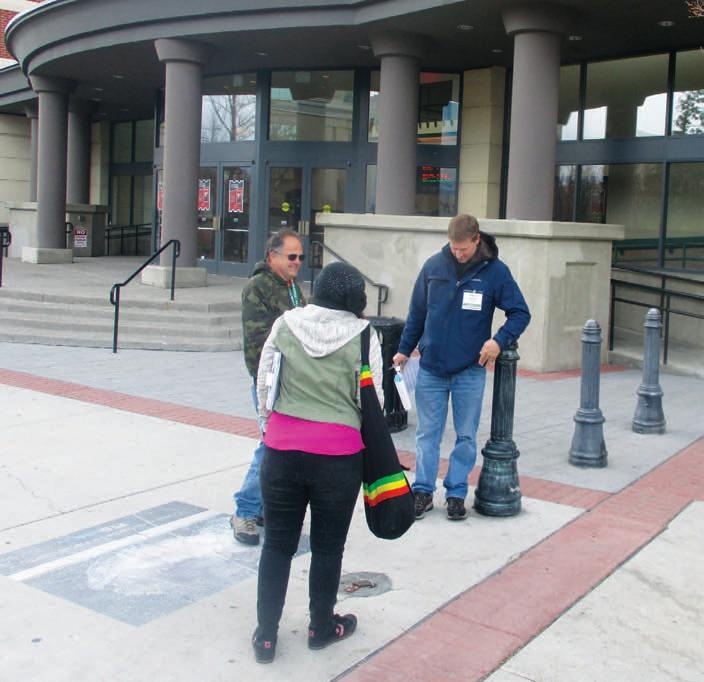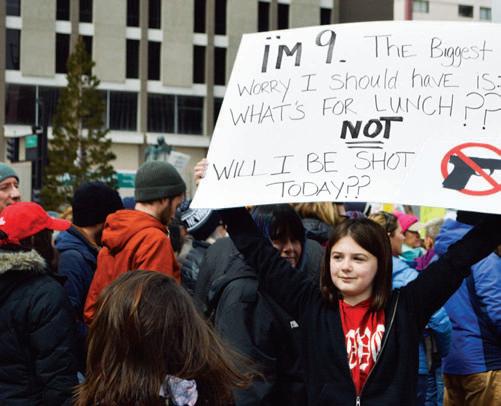
8 minute read
NEWs
from March 29, 2018
Bloat redux
Under the War Powers Resolution, the Department of “Defense” is required to report on where U.S. troops have been sent into “hostilities or into situations whose imminent involvement in hostilities is clearly indicated by the circumstances.” Note that the language does not stop at “hostilities.” Rather, it then adds a 12-word qualifier beginning with “situations” that make it a judgment call by the Pentagon whether to report on all places where troops are in hostilities.
Advertisement
In this year’s war powers report, the Pentagon has reported on Afghanistan, Yemen, Iraq and Syria, Somalia, Libya, and Niger—but nowhere else.
For instance, U.S. troops have been in the Philippines since the second Bush administration, which sent them there on an alleged anti-terrorism mission, though it is described by other sources as an internal insurgency. Kerry Firth of Nevada is among U.S. soldiers who have since died in the Philippines, but the new war powers report contains no reference to those hostilities.
On June 14 last year, the New York Times reported from Mindanao, “American troops are on the ground in the embattled southern Philippine city of Marawi, where the Philippine military is battling Islamic State-linked militants for control, a Philippine military spokesman said on Wednesday.” At that time, Philippine President Rodrigo Duterte said he was unaware of U.S. forces being in Marawi.
Agence France-Presse reported, “U.S. troops are on the ground helping local soldiers battle terrorists in a Philippine city, a Filipino military spokesman said on Wednesday, June 14, giving the most detailed account of their role. The small number of U.S. soldiers are providing vital surveillance assistance and, although they do not have a combat role, are allowed to open fire on the militants if attacked first, spokesman Brigadier-General Restituto Padilla said.”
Reuters reported besides those troops in Marawi, Pentagon officials said there were “an additional 300 to 500 troops in the country to support regular training and activities, without giving further details.”
This year, Australia’s Sydney Herald reported, “The United States will upgrade and build facilities on Philippine military bases this year, Manila’s defence minister said, bolstering an alliance strained by President Rodrigo Duterte’s opposition to a U.S. troop presence.”
Although the law requires that there be an unclassified summary of the war powers report, the Trump administration made it as difficult as possible for the public to read the unclassified portion. It was not released publicly. Instead, it was sent out to Congress and had to be viewed there. LawFare, a national security blog, reported that “the White House has limited public disclosure of the report to a cover letter indicating that the document has been transmitted to Congress. But, over the course of the day on Tuesday, the congressional committees began to receive copies of the unclassified report. So, curious as to what it said, we decided to head down to Capitol Hill to review it in person, an underappreciated option for many congressional reports. While relevant committee rules did not allow us to make copies or take pictures of the report, we were able to spend a few hours with a hard copy.” Fortunately, Slate, the New York Times and other publications obtained copies and posted them online.
And although the Pentagon has world class technical facilities, the report is put out in primitive fashion, akin to mimeograph, including a format in which text cannot be highlighted and lifted out but must be copied word by word.
The war powers report can be read here: tinyurl.com/ ybwh3ayd Temporary workers gather signatures in downtown Reno for an initiative petition sponsored by Tom Steyer.
PHOTO/DENNIS MYERS
Petition
A billionaire invests in Nevada renewable energy
the streets of downtown reno on March 24 were filled with people, and to two men seeking signatures on a petition, they were the right kind of people. The March for Our Lives had taken place that morning in downtown, and, afterward, participants scattered to coffee shops, stores and movies. It was outside the downtown movie theaters that the two men set up, gesturing with clipboards containing the petitions.
The petition is headed, “Renewable energy promotion initiative” and if it gets the required number of signatures and is enacted by voters, it would require increased reliance by state utilities on renewable sources “such as solar, geothermal and wind” to 50 percent. It would happen on a sliding scale—at least 26 percent in 20222033, 34 percent in 2024-2026, 42 percent in 2027-2029, and 50 percent in 2030 and thereafter.
The Nevada initiative petition is sponsored by Tom Steyer, a former hedge fund manager worth more than $1.6 billion who has pledged to spend half his fortune on good works. The petition was filed with the Nevada Secretary of State on Feb. 6.
There was a time when renewables were considered so impractical that someone—Ralph Nader is often credited—said that solar energy would be impractical “until the oil companies get a franchise on the sun.” That time is long past, in part because oil and other energy companies did buy up small energy research firms. Today, renewables are not only practical but have become economically competitive.
Still, the pace of switching over to renewables has not satisfied its supporters—some of whom have a financial stake in that switch. Right now, Nevada requires that 25 percent of electricity sales be derived from renewables by 2025. In 2016, the state reached 21.6 from biomass, geothermal, hydroelectric, solar and wind.
Steyer is trying to hurry that process along in at least three states— Michigan, where his initiative seeks 30 percent of renewables by 2030 and Arizona and Nevada, where 50 percent by 2030 is the goal.
But his Nevada and Arizona initiatives both have a feature that has made critics out of even some supporters of renewables. Both his initiative petitions for the states seek to write the thresholds into the state constitutions instead of state statutes.
Jon Wellinghoff, former federal and Nevada energy official and now CEO of Grid Policy Inc., said he supports the objectives of the measure but believes statutory legislation would be a better way of achieving it.
In Arizona, Democratic state legislators Robert Meza and César Chávez of Phoenix wrote in an essay in the Arizona Republic, “Arizonans should be careful. If voters approve this initiative, it will be locked into the Arizona Constitution and virtually impossible for policymakers to make corrections or account for changes in technology or the marketplace.”
In Nevada, if the Steyer petition were approved by voters and turned out to contain flaws, state legislators would be unable to make corrections in it for at least three years. The Arizona petition reportedly excludes nuclear as a renewable, but the Nevada petition seems to leave the definition of what is a renewable energy source up to the legislature.
The Nevada Constitution is more than 49,000 words long and contains many provisions that are not generally thought of as the stuff of constitutions. When including 27 amendments, the U.S. Constitution contains 7,591 words.
legislative games
There could also be other problems ahead for Steyer’s initiative, if his experience in Arizona is any indication.
The Arizona Legislature is known for its provocative stances, as when in 1996, after Arizona and California voters approved the nation’s first medical marijuana initiatives, Arizona lawmakers promptly repealed it. Then, of course, there are its anti-immigrant measures.
After Steyer’s petition was filed, Wellinghoff said, the Arizona Legislature “smoked” it.
“What they did was say, OK, you can set the energy standards anywhere you want, but we’re going to say the penalty is just $5,000,” he said.
In fact, that is the top penalty. Fines could fall as low as $100—chump change to utilities. It would essentially make it painless for utilities to ignore the law. Or, to put it another way, breaking the law would become just another cost of doing business.
Could something similar happen in Nevada?
In the closing days of two consecutive Nevada Legislatures with Democratic majorities—2011 and 2013—NVEnergy lobbyists suddenly produced measures that they dared not produce earlier, when scrutiny would have been heavy. Legislators jumped to break house rules to accommodate them. One of the measures—an amendment to Senate Bill 123 in 2013—would have circumvented the regulatory process. “Never before has a bill been introduced that has such guarantees to [utility] shareholders,” said former Nevada Attorney General Frankie Sue Del Papa.
Later, under a Republican majority, the 2015 Nevada Legislature enacted Senate Bill 374, which the Public Utilities Commission later used to shut down the state net metering
program, which caused Nevada solar firms to close down and even leave the state. In other words, history shows the Nevada Legislature is susceptible to doing the bidding of power utilities. Steyer’s initiative comes at a time when Western utilities are changing. While they may not be moving as quickly as their critics want, they are embracing renewables. Nevada now has 16 solar plants, including two opened in December by NVEnergy. A coal plant in Nevada with a reputation as a particularly dirty facility that caused health problems—Reid Gardner, in How fast is southern Nevada—has been shut down. Coal-fired Valmy fast enough? in northern Nevada remains open and is the subject of a tug-of-war between its two owners—Idaho Power, which wants the plant shut down as soon as possible, and NVEnergy, which wants to keep it open through 2025. As Utility Dive reported last year, “Western states are slowly weaning off their reliance on coal-fired generation as economic and political pressure to shut down the carbon-intensive plans builds.” On the other hand, NVEnergy seemed to assign less urgency to closing Valmy after Harry Reid left office and the coal-hating senator was no longer looking over the utility’s shoulder. Ω
Sign of the times

A young woman held aloft a sign she made for the March for Our Lives protest, which—according to the Reno Police Department—brought at least 3,000 people to downtown Reno on March 24. Protestors marched down South Virginia Street from the Bruce R. Thompson Federal Building to the Reno City Plaza. The event was one of many that took place across the globe in response to the Feb. 14 shooting at Marjory Stoneman Douglas High School in Parkland, Florida, which claimed the lives of 17 students and members of the school’s staff.
















